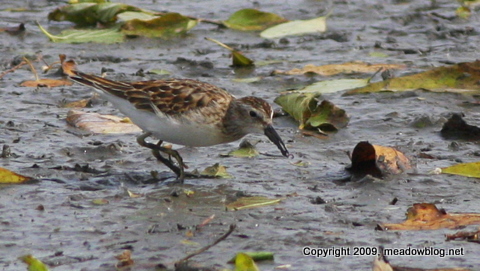Earlier this month, we posted a photo of a small shorebird and asked for help with the ID — with the understanding that IDing any bird from a single photo can be tricky at best. (Link is here.)
We were thinking to ourselves that it might be a Western Sandpiper, and were surprised at the variety of responses.
One birder thought was a Western Sandpiper. Others thought it was a Dunlin. Another thought it was a juvenile White-rumped Sandpiper.
We decided to ask Kevin Karlson, author of "The Shorebird Guide," for his diagnosis: "None of the above."
Click "Continue reading…" for Kevin's verdict, and the thinking that went into it.
Kevin writes:
The bird in question is a juvenile Least Sandpiper with a few non-breeding feathers molting in on the back. Leg color on juvenile Least can range from greenish yellow to dull olive, which is what this bird is showing (not to mention the mud caked on the legs as well).
Most birders disregard the obvious field marks of tiny head; overall rufous tones to the upperparts, including the head; brownish collar; and slender body with a crouching posture typical of Least Sandpiper; and thin bill with pointed, slightly decurved tip and just key in on the fact that the legs don't match their favorite illustrated field guide.
I warn birders to put non-conforming bare parts color in the background if it is the only feature that does not conform to expected field marks, like this bird, and rely on the obvious features, including body and bill structure; leg length; and plumage features.
If you did that to your bird, not to mention the tiny size that only you would have noticed when you photographed it but did not mention in your question of identity, Least Sandpiper would have been an obvious choice.
There is no other peep sandpiper that fits the structural and plumage features of Least except Long-toed Stint, and the structural features (long toes like a gallinule; long neck; chesty Pectoral Sandpiper appearance) do not match this extreme rarity.
Your bird is a very common migrant at the Meadowlands, juvenile Least Sandpiper.


Kevin is amazing. Thank you for this and for asking for his input, as I will never get it…LOL!~